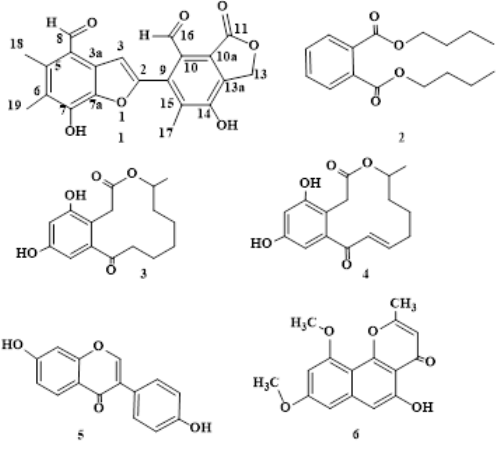
New polyoxygenated polyketide from pathogenic fungus Cylindrocarpon destructans with α-glycosidase inhibitory activity
Abstract
Phytochemical investigation on pathogenic fungus Cylindrocarpon destructans isolated form Meconopsisgrandis plant led to the isolation of one new polyoxygenated polyketides, namely cylindrocarpolide A along with five known compounds. The structures of the isolated compounds were elucidated by 1D and 2D NMR and mass spectroscopic data analysis. The isolated compounds were evaluated for α-glycosidase inhibition activity. The compounds isolated compounds were found to have strong to weak inhibition against the α-glycosidase enzymes
Full Text:
PDFReferences
- D. Brayford, Cylindrocarpon. In: Methods for research on soil-borne phytopathogenic fungi. (Singleton LL, Mihail JD, Rush M, eds). APS Press, Saint. Paul, U.S.A.1993, 103-106.
- C. Booth, The Genus Cylindrocarpon. Mycological Papers No. 104, Commonwealth Mycological Institute, England, pp. 1966,35-37.
- K. A. Seifert, C. R. McMullen, D. Yee, R. D. Reeleder and K. F. Dobinson, Molecular differentiation and detection of ginseng-adapted isolates of the root rot fungus Cylindrocarpon destructans, Phytopathology, 2003b, 93, 1533-1542.
- D. R. Maluta and P. Larignon, Pied-noir : mieuxvautprévenir. Viticulture, 1991,11,71-72.
- S. Grasso andS. L. di Magnano,Infections of Cylindrocarpon obtusisporum on grape vines in Sicily, Vitis, 1975, 14, 36-39.
- H. J. Scheck, S. J. Vasquez, D. Fogle and W. D. Gubler, Grape growers report losses to black-foot and grapevine decline,Calif. Agric.,1998a,52, 19-23.
- J. Kaliamurthy, C. Jesudasan, D. A. Prasanth and P. A. Thomas. Keratitis due to Cylindrocarpon lichenicola, J. Postgrad. Med., 2006, 52, 155-157.
- T. Gaujoux, E. Borsali, J. C. Gavrilov, O. Touzeau, P. Goldschmidt and M. O. Despiau.Fungal keratitis caused by Cylindrocarpon lichenicola, J. Fr. Ophtalmol., 2012, 35(5), 356.
- D. E. ZoutmanandL. Singler. Mycetoma of the foot caused by Cylindrocarpon destructans, J. Clin. Microbiol., 1991, 29 (9), 1855-1859.
- R. Sharma, C. K. Farmer, W. R. Gransden and C. S. Ogg, Peritonitisin continuous ambulatory peritoneal dialysis due to Cylindrocarpon lichenicola infection, Nephrol. Dial. Transplant., 1988, 13, 2662-2664.
- B. Lancy, C. Blanc and J. Lapalu, Cylindrocarpon: a new athlete's foot agent, Bull. Trimest. Soc. Mycolo. Fr., 1985, 14, 73-76.
- R. Sharma, C.K. Farmer, W. R. Gransden and C. S. Ogg. Peritonitisin continuous ambulatory peritoneal dialysis due to Cylindrocarpon lichenicola infection. Nephrol. Dial Transplant., 1988, 13, 2662-2664.
- P. C. Iwen, S. R. Tarantolo, D. A. Sutton, M. G. Rinaldi and S. H. Hinrichs, Cutaneous infections caused by Cylindrocarpon lichenicolain a patient with acute leukemia, J. Clin. Microbiol., 2000, 38 (9), 3375-3378.
- E. A. James, D. K. Orchar, P. H. Mcwhinney, D. W. Warnock, E. M. Johnson and A. B. Mehta, disseminated infection due to Cylindrocarpon lichenicola in a patient with acute myeloid leukemia, J. Infect., 1997, 34, 65-67.
- K. Diongue, M. A. Dialloa, M. C. Secka, M. Ndiayea, A. S. Badianea, A. Diop, Y. D. Ndiaye, O. Ndir and D. Ndiaye, Tinea pedis due to Cylindrocarpon lichenicola beginning onycholysis, Med. Mycol. Case Rep., 2016, 11, 13-15.
- H. Champa, P. Sreeshma, P. Y. Prakash and M. Divya, Cutaneous infection with Cylindrocarpon lichenicola, Med. Mycol. Case Rep., 2013, 2, 55-58.
- C. Booth, Y. M. Clayto and M. Usherwood, Cylindrocarpon species associated with mycotickeratitis, Proc. Ind. Acad. Sci., 1985, 2 (3), 433-436.
- K. Mio, F. Takashi, U. Ryuji, N. Kenichi, M. Rokuro and T. Hiroshi, A new ascochlorin derivative from Cylindrocarpon sp. FKI-4602, J. Antibiot., 2013, 66, 23-29.
- B. S. Sheo, G. B. Richard, F. B. Gerald, C. Carmen, B. G. Jackson, A. G. Michael, H. Karst, G. J. Rosalind, M. L. Jerrold, B. L. Russell, C. S. Keith and L. Z. Deborah, Chemistry and Biology of Cylindrols: Novel Inhibitors of Ras Farnesyl-Protein Transferase from Cylindrocarpon lucidum, J. Org.Chem., 1996, 61, 7727-7737.
- W. Daniela, E. Gilda, S. Olov and A. Timm., Cylindrocyclin A, a New Cytotoxic Cyclopeptide from Cylindrocarpon sp, J. Antibiot., 2006, 59 (8), 495-499.
- G. R. Margarita, T. Cristina, R. Jaime, L. Mauricio and S. H. Guillermo. Bioactive Metabolites from the Fungus Nectria galligena, the Main Apple Canker Agent in Chile, J. Agric. Food Chem., 2005, 53, 7701-7708.
- G. Evans and N. H. White., Radicicolin and radicicol, two new antibiotics produced by Cylindrocarpon radicicola, Trans. Brit. Mycol. Soc., 1966, 49(4), 563-576
- Y. Liu, Q. Yang, G. Xia, H. Huang, H. Li, L. Ma, Y. Lu, L. He, X. Xia and Z. She, Polyketides with a-glucosidase inhibitory activity from a mangrove endophytic fungus Penicillium sp, J. Nat. Prod., 2015, 78, 1816-1822.
- F. M. Talontsi, B. Dittrich, A. Schüffler, H. Sun and H. Laatsch,Epicoccolides: Antimicrobial and Antifungal Polyketides from an Endophytic Fungus Epicoccumsp, Associated with Theobroma cacao. Eur.J. Org.Chem., 2013, 3174–3180.
- T. Ahsan, J. Chen, X. Zhao, M. Irfan and Y. Wu, Extraction and identification of bioactive compounds (eicosane and dibutyl phthalate) produced by Streptomyces strain KX852460 for the biological control of Rhizoctonia solani, AG-3 strain KX852461 to control target spot disease in tobacco leaf. AMB Expr., 2017, 7: 54
- T. M. Ha, W. Ko, S. J. Lee, Y. C. Kim, J. Y. Son, J. H. Sohn, J. H. Yim and H. Oh, Anti-Inflammatory Effects of Curvularin-Type Metabolites from a Marine-Derived Fungal Strain Penicillium sp. SF-5859in Lipopolysaccharide-Induced RAW264.7 Macrophages, Mar. Drugs., 2017, 15, 282-293.
- J. He, P. Fan, S. Feng, P. Shao and P. Sun, Isolation and Purification of wo Isoflavones from Hericium erinaceum Mycelium by High-Speed Counter-Current Chromatography. Molecules, 2018, 23, 560.
- A.M.D.A. Siriwardanea, N. S. Kumar, L. Jayasinghe and Y. Fujimoto., Chemical investigation of metabolites produced by an endophytic Aspergillus sp. isolated from Limonia acidissima, Natural Product Research, 2015, 29, 1384-87.
DOI: http://dx.doi.org/10.13171/mjc74181124-dilfaraz
Refbacks
- There are currently no refbacks.
Copyright (c) 2018 Mediterranean Journal of Chemistry
